
T he Back Story I am not a chef. I have no formal training in anything culinary related, although I have been to quite a few Pampered Chef parties (for the record, the handheld chopper rocks). What I do have is a deep and abiding love for my slow cookers. I got my first slow cooker on my twenty-first birthday, along with a food dehydrator and a pasta machine.
I was engaged to be married, and thought I should learn to be a bit more domestic. I had only used the food dehydrator and pasta machine a few times before shoving them into the back of a kitchen cabinet. I found the prep work and ensuing mess daunting, and I wasnt enamored of the shriveled fruit and squishy pasta. But my slow cooker? My slow cooker gave my domestic side a much-needed boost of esteem. This was a machine I could use. I was fascinated with the way this simple device was able to transform a forgotten and frostbitten roast from the back of the freezer into quite a tasty meal.
I was amazed at how effortlessly I could throw together soups and stews, and how tender and moist chicken breasts could become when almost completely ignored. I continued to use my slow cooker through the early years of my marriage, and fell in love with it all over again when I became a mother. I quickly learned that the only way to ensure a proper family dinner at 6:00 PM was to get the slow cooker loaded up early in the morning while I was still caffeinated and coherent. It just wasnt safe to chop vegetables during the afternoon witching hours with cranky kids hanging from my ankles, and once my children hit school age, we spent our afternoons and early evenings at scout meetings or on the sports field. Slow cooking became a way of life. In January of 2008, I took my love of the slow cooker to the Internet.
I began working for BlogHerads.com, and knew that in order to better understand my job, I should begin a blog. I was hesitant to share too many personal details with the Internet, and liked the idea of a food blog. But I didnt really know how to cookI just liked to use my slow cookers! When I joked with my husband that I should make a New Years resolution to use my slow cooker daily and write about it online, Adam told me to go for it. On January 1, 2008, A Year of Slow Cooking was born. When I began my yearlong adventure, I didnt think I would come up with new recipes or uses for the slow cooker, and I didnt think anyone reading along at home would attempt to make any of the food I presented. This changed on Valentines Day, 2008, when I made a perfect crme brle at home, in my tiny kitchen, in the slow cooker.
I was thrilled that this delicate dessert came out so well, and decided to e-mail the Rachael Ray television show to share my discovery. A producer called a few weeks later, and I flew to New York to appear in person on the show. After this appearance, my handful of daily readers grew to a few thousand, and I was asked to assemble the recipes from my yearlong adventure into a book. My first cookbook, Make It Fast, Cook It Slow: The Big Book of Everyday Slow Cooking is a compilation of 338 of the very best recipes from my year of slow cooking. I am quite proud of that book, and am overjoyed that I had the opportunity to share my slow cooker experiences with so many people. While the recipes presented in my first book are delicious, fun, and at times revolutionary, they dont reflect another one of my passions: saving money.
Although I can make a fantastic lobster bisque in the slow cooker, this isnt really a practical meal for most busy families. This new book has 200 brand-new recipes that will bridge the gap between being innovative and practical. Although all these dishes fit into a specific budget, I am happy to state that the included recipes do not skimp on flavorI have chosen hearty, delicious selections, covering all meals from breakfast to dessert. I hope you enjoy it. A re You Cheap? Frugal? Responsible? Does It Really Matter? I dont like wasting money. Im a sucker for a bargain, and have a hard time buying anything without first double-checking the price tag.
Ive been teased in the past and called cheapand while I used to feel embarrassed, this is now a label I wear proudly. When I first joined the workforce, I kept a loaf of bread in my desk drawer and a jar of peanut butter with my name on it in the communal refrigerator. Instead of joining my coworkers for a daily restaurant or deli lunch, I munched on my bread and peanut butter. Im not sure exactly how much money I saved by doing this, but Id guess it to be in the neighborhood of a few thousand dollars. I have a hard time spending top dollar for items when I know that if I just apply myself, I can usually find the same thing (or something quite similar) at a lesser price at a different store or an online retailer. That said, Im also practical, and know that I cant really spend a lot of my time hopping around grocery stores hunting for the best deal.
Instead, I try my hardest to plan my meals around seasonal fruit and vegetables, and to stock up on meat and other high-priced items when they are on sale at my favorite neighborhood grocery store. Ive found that by sticking to the same store and keeping to my list, I fare better than driving to a new store to cash in on an advertised price. Unfamiliar stores encourage aisle wandering, and Im much more prone to impulse shop at a new-to-me store. Regardless of your financial situation, Im sure we all know what its like to worry about bills and expenses, and to lie awake at night concerned about the future. Its no fun. Ive read an awful lot about trimming expenses from the family budget, and it seems the quickest and easiest way to find a bit of extra wiggle room at the end of the month is to pay attention to your purchases at the grocery store.
Using the slow cooker is a fantastic way to trim the fat from your grocery bills. I appreciate that I can use dried beans and inexpensive cuts of meat. I like that, more often than not, a slow cooker dish provides leftovers I can pack for lunch, or stretch into another family meal by serving it over rice or pasta, or using the bits and pieces as a base for soup. With help from the slow cooker, you can stock the freezer with homemade broth, pasta sauce, and slow cooker TV Dinners (page 6). You can freeze your own cooked beans to use in your favorite recipes, and make homemade yogurt and baby food. You can cook a whole chicken for its meat, and then use the carcass for broth.
Since I began using my slow cookers daily, Ive learned that the average amount of energy used for slow cooking is similar to that of a desk lamp: 75 watts on low, and 150 watts on high. This is much less energy use than an oven, stove, or barbecue requires. A bout This Book There are over 200 brand-new recipes in this book that have not been shared in the first Make It Fast, Cook It Slow cookbook. The recipes included have been chosen because they are inexpensive to make. I have separated the book into three sections: $7 and under, $10 and under, and $15 and under dishes. Within each section, there are chapters for beverages, appetizers, soups and stews, side dishes, main courses, and desserts.
The main-course selections are bountiful, because I believe this is the most beneficial. I have also included a section Ive entitled Staples. This section has recipes from my first book that I felt were important to this one, such as making homemade broth, yogurt, and baby food in the slow cooker. I live in the San Francisco Bay Area, which happens to be a terribly expensive place to live. The prices in this book are from my own hometown, from my own (regional chain) neighborhood grocery store. I did not use coupons to purchase the food, although I did choose to buy items when they were on sale, and chose store brand items if the per-ounce cost was less expensive than that of the name brand.

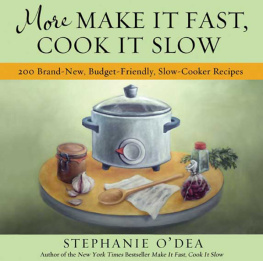
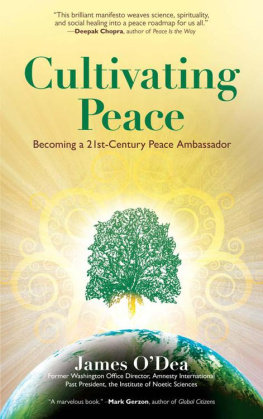

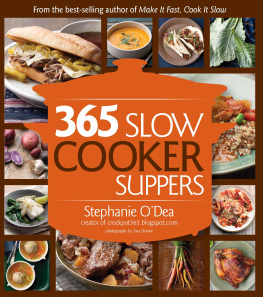

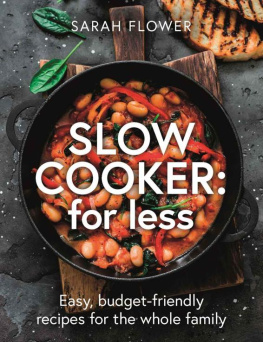

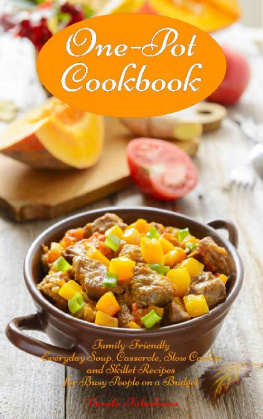


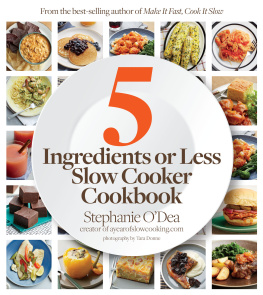
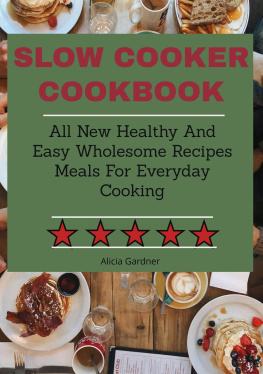
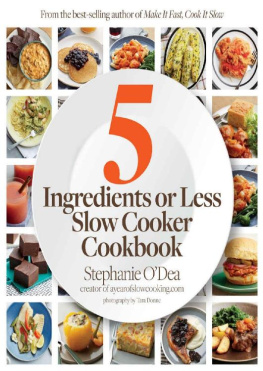
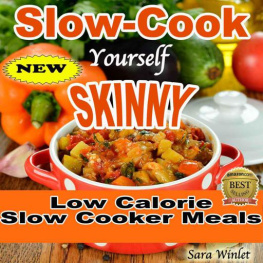
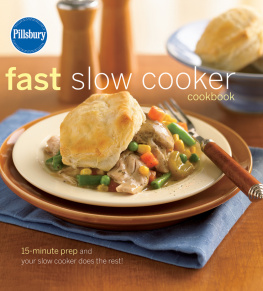

 To my
To my T he Back Story I am not a chef. I have no formal training in anything culinary related, although I have been to quite a few Pampered Chef parties (for the record, the handheld chopper rocks). What I do have is a deep and abiding love for my slow cookers. I got my first slow cooker on my twenty-first birthday, along with a food dehydrator and a pasta machine.
T he Back Story I am not a chef. I have no formal training in anything culinary related, although I have been to quite a few Pampered Chef parties (for the record, the handheld chopper rocks). What I do have is a deep and abiding love for my slow cookers. I got my first slow cooker on my twenty-first birthday, along with a food dehydrator and a pasta machine.